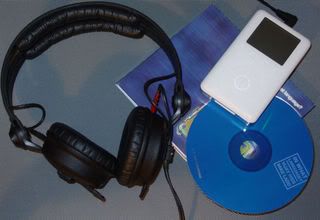The HD25-1 is primarily a DJ-style phone and as such incorporates such features as a earcup which swings off the ear for single-sided monitoring. It features a very strong steel cable for connection which is lower quality sound wise than an OFC cable, but still very usable. The headband splits in two to create an adjustable cradle for the head, which means no matter how much head-banging you're doing, it's unlikely for these to fall off. The earcups sit on top of the ears (supraaural) and clamp pretty hard to achieve possibly the highest degree of isolation on a lightweight headphone. Despite the clamping force it is not unduly uncomfortable, especially if you get used to it.

The phone is light and compact enough to fit in most bags despite the fact that it does not fold. The headphone cable comes down on the right hand side, which is opposite to most phones. This may cause problems for those with remotes, but the near-1 metre cable is long enough to be routed sensibly.
The sound itself is quite well resolved and bright, with a punchy but not overdone bass. There isn't a midrange suck-out which is a facet of some brighter phones, and for the treble to stick out as much as it does on the HD25-1 through the forward and powerful midrange, it means that the treble is very emphasised. This leads to the highs sounding slightly rougher and more sibilant than necessary. The bass impact on these phones is excellent, being tight and deep (30hz is very easily discernible), and hits harder than any higher-end 'canalphone' (phones which fit inside the ear canal to provide isolation and high quality sound), the other very popular portable phone option. Due to the forward midrange previously mentioned, soundstaging width is not a huge feature of the HD25-1. It does enough and is similar to 'canalphones', but a wide, spacially fully realised feeling is not possible from the HD25-1 no matter how grand the recording. These are definitely suitable for pop and rock and will get your head nodding, but it's maybe not the ideal phone for a private performance of Aida.
The HD25-1 is very efficient, which means that minimal power is required to drive this headphone to an acceptable level. As a result, you can get involving and powerful music from even portables which have been 'crippled' to meet European regulations regarding maximum permissible sound levels.
Finally, just a note about summer or hot climates. Because the phones create their isolation by maintaining a seal around your ears, your lobes can get pretty sweaty... and that contributes to an overall feeling of hotness. If the HD25-1 is exclusively for hot summer use, I can't make that strong a recommendation because they really do get quite stuffy. In this situation, take a look at one of the in-ear 'canalphones' for which I'll be dropping reviews in later. In most temperate situations though, I doubt you'll have a problem.
If you listen mostly from a portable audio player while moving around, and don't want to use the premium 'canalphones' which go inside the ear to provide isolation, the HD25-1 is the most viable option. Rather expensive at a typical $200, but in terms of what you get it is worth it.
Manufacturer Link (UK site)
March '05 edit:
Since this was posted, I've been playing with alternative cables for the HD25-1. Since the HD25-1 has the same connectors as the Sennheiser HD6xx series, it's possible to try various different cables... most of which are unsuitable in a portable role. Changing the steel cable to an OFC cable makes a far bigger difference between the HD25-1 and the cheaper HD25-SP. The only problem is that you'll need to shorten and re-terminate the appropriate cable (Sennheiser part no: 74532, 3.5m OFC cable terminated with 6.5mm jack) in order for it to be of much use in a portable environment.
No comments:
Post a Comment